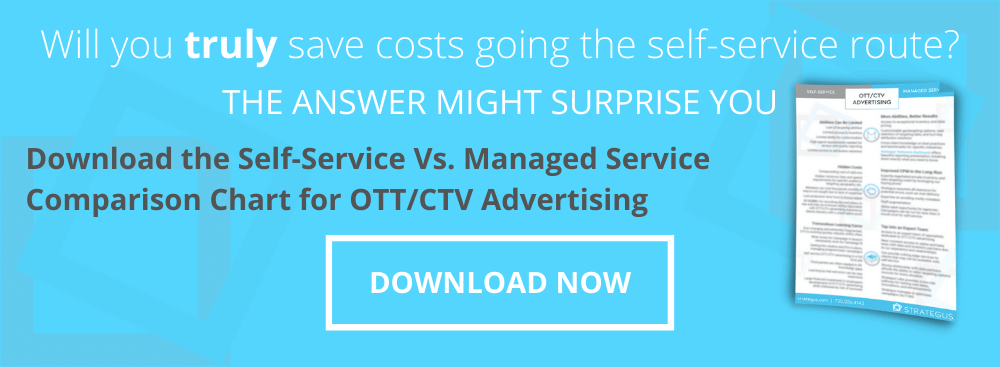- Home
- Strategus Blog
- How Does LTVE Optimize Reach for Advertisers
How Does LTVE Optimize Reach for Advertisers
 Andy Dixon
Andy Dixon
6 minutes read

Both OTT/CTV television and traditional linear broadcasting are useful for marketers who want to target their advertisements to a well-defined audience.
They each have their own advantages, such as the broad market reach and legitimacy of linear TV ads and the in-depth analytics and control OTT platforms offer.
However, the strongest advertising campaigns often use a strategic mix of the two. Digilant emphasizes the importance of both platforms with the number of viewers alone:
"At the start of 2021, 70 million households maintained cable subscriptions, while at the same time, advertisers could reach more than 84 million households via connected streaming TV services (according to Statista)."
Rather than making the switch to digital streaming and leaving households with broadcast television on the table, it's time to create a strategy that incorporates both. This doesn't mean duplicating your ads on both platforms.
Instead, it means weaving your campaigns together so CTV ads effectively reach audiences that broadcasting alone didn't. In this article, we'll explore how to efficiently and cost-effectively use LTVE to close the gaps in your advertising reach.

The Goal of Advertising Reach
There are two key measurements in advertising when you're trying to get an advertising message in front of your target audiences: reach and frequency. Frequency is the number of times an individual is exposed to your ads within the day, week, or other set measures of time. Reach is the number of people exposed to an ad in the specified time period.
In addition to geography, there are other factors that can limit who does and doesn't view your ad. For example, many households won't have broadcast television or aren't home when your ad plays. Other audiences may have changed the channel or were in the other room. Regardless of the reason, viewers who don't see your ad, even when you paid for that exposure, can't be moved along the buyer's journey.
However, you don't want to simply increase reach; that can be costly and ineffective. Instead, you want to optimize reach: reach the viewers who are actually in your target market without overwhelming viewers who have seen your ads at the right frequency already.
A quick look at lift
Having optimal reach is about more than getting eyes on your ads. It's about making sure viewers see your ads in the right context at the right time to achieve brand lift. By measuring advertising lift, you have better insight into how viewers respond to an ad.
Some viewers who see an ad through a streaming television service might respond well to a retargeted ad and immediately click through the ad to the advertiser's site to make a purchase; others might bookmark the site.
Viewers who see a broadcast television ad might become more amenable to a pushed ad on their phone later that they would have otherwise ignored. You and your marketing team need to know how your ads affect your audience — and their behaviors — so you can create the most streamlined journey to a long-term customer relationship and do away with the ads that are underperforming.
How Does LTVE Optimize Reach?
Linear TV extension (LTVE) is built for linear television advertisers who prefer to focus on traditional broadcast television audiences. However, while linear television allows for a predetermined geographic range and generally predictable demographics, it doesn't allow for the granular insight OTT/CTV platforms provide.
LTVE uses automated content recognition to help advertisers identify households that didn't see your linear television advertisements or had relatively light exposure to your messaging. Why is this so useful? Instead of moving on to CTV ads that presume your audiences already have knowledge about your brand, you can send them ads better aligned to new viewers without feeding already-exposed viewers the same ad.
LTVE Methodology
Our LTVE methodology is a three-step process for closing the gaps in your broadcast advertising viewership. Those three steps are:
- Identify: Our tools use ACR data to pinpoint which households within your broadcast TV range were actually exposed to your ads. We also determine the extent of that exposure.
- Forecast: Our tools forecast the number of market households that didn't receive any exposure or were underexposed to your campaign.
- Reach: You can then use CTV campaigns to reach those missed households as first-time or new viewers.
This methodology is critical even with simple campaigns, as carefully repeated exposure can increase brand familiarity and keep your brand top-of-mind. But it's essential in complex storytelling campaigns that require sequential exposures.
LTVE IN ACTION
To better understand how LTVE works, let’s consider this hypothetical. A client wanted to extend the reach of their linear TV campaigns in the San Francisco area so under-exposed households with children didn't fall through the cracks. They identified 1.7 million households in the area that weren't properly exposed to their messaging.
Our LTVE tool can identify the exposure threshold by discovering 13.7 views as the average household frequency. Armed with that number, advertisers can better identify the optimal frequency, avert ad fatigue, and know which households are under-exposed.
However, because optimizing is always better than increasing, our tools would recommend a maximum budget of $200,000 to reach between approximately 420,000 and 610,000 households. While they could have chased all of those households, overspending would only result in marginal and decreasing returns.
Optimize Your OTT/CTV Video Ad Reach With Strategus
Linear TV is a great platform for reaching households within your target market area, but you may not reach everyone the right number of times to achieve your marketing goals. With LTVE, you can supplement your advertising campaigns with a purposeful focus on the households that need more attention.
At Strategus, we're here to help ensure you can optimize your reach for cost-effective marketing and brand lift. Contact us today to learn more about the effect that LTVE can have on brand lift.


Andy Dixon is a seasoned Content Writing Specialist at Strategus, renowned for his expertise in creating engaging and impactful digital content. With over a decade of experience in content creation, Andy has honed his skills in a variety of niches, ranging from technology and marketing to education.
Strategus is a managed services connected TV(CTV) advertising agency with over 60,000+ campaigns delivered. Find out how our experts can extend your team and drive the result that matter most.
Talk to an Expert
Seeking a Custom CTV Strategy That Delivers?
What to read next

Best SVOD Platforms for Advertisers
The streaming wars have a new battlefront, and this time, it's all about your ad budget. Just a few years ago, SVOD meant "no commercials." Now, it...
12 minutes read

Third-Party Data Targeting for CTV: Benefits & Tactics
Third-party data. It’s a term that’s thrown around, and yet few take the time to detail its pros and cons — much less strategies for using...
7 minutes read

First-Party Data Targeting: Benefits and Tactics for CTV Advertising
First-party data is the information that companies collect directly from their customers rather than through intermediaries. Advertisers use this...
10 minutes read

Foot-Traffic Attribution: Tying Ad Impressions to In-Store Visits
The marketing funnel has changed. Today’s shoppers often begin researching products from the comfort of their homes and don’t set foot into a store...
8 minutes read
















